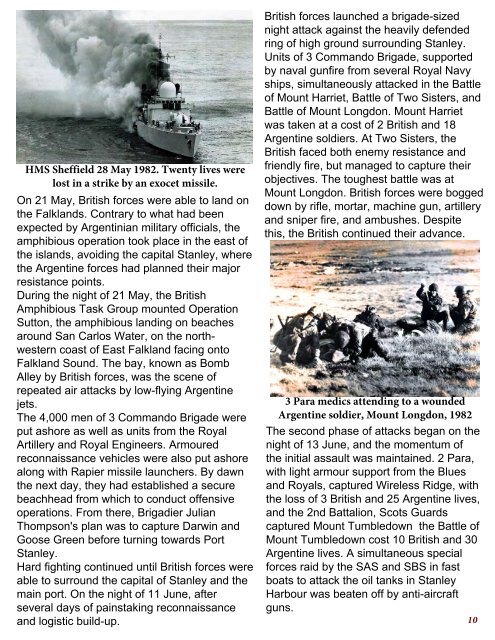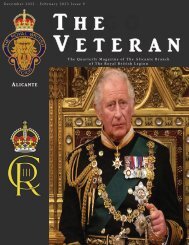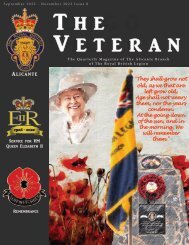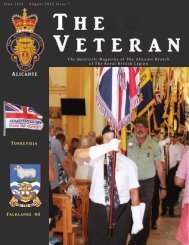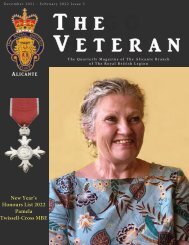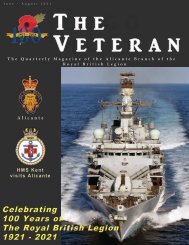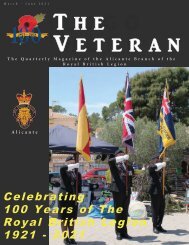The veteran Issue 6
The quarterly magazine of the Alicante Branch of the Royal British Legion, issue 6
The quarterly magazine of the Alicante Branch of the Royal British Legion, issue 6
Create successful ePaper yourself
Turn your PDF publications into a flip-book with our unique Google optimized e-Paper software.
HMS Sheffield 28 May 1982. Twenty lives were<br />
lost in a strike by an exocet missile.<br />
On 21 May, British forces were able to land on<br />
the Falklands. Contrary to what had been<br />
expected by Argentinian military officials, the<br />
amphibious operation took place in the east of<br />
the islands, avoiding the capital Stanley, where<br />
the Argentine forces had planned their major<br />
resistance points.<br />
During the night of 21 May, the British<br />
Amphibious Task Group mounted Operation<br />
Sutton, the amphibious landing on beaches<br />
around San Carlos Water, on the northwestern<br />
coast of East Falkland facing onto<br />
Falkland Sound. <strong>The</strong> bay, known as Bomb<br />
Alley by British forces, was the scene of<br />
repeated air attacks by low-flying Argentine<br />
jets.<br />
<strong>The</strong> 4,000 men of 3 Commando Brigade were<br />
put ashore as well as units from the Royal<br />
Artillery and Royal Engineers. Armoured<br />
reconnaissance vehicles were also put ashore<br />
along with Rapier missile launchers. By dawn<br />
the next day, they had established a secure<br />
beachhead from which to conduct offensive<br />
operations. From there, Brigadier Julian<br />
Thompson's plan was to capture Darwin and<br />
Goose Green before turning towards Port<br />
Stanley.<br />
Hard fighting continued until British forces were<br />
able to surround the capital of Stanley and the<br />
main port. On the night of 11 June, after<br />
several days of painstaking reconnaissance<br />
and logistic build-up.<br />
British forces launched a brigade-sized<br />
night attack against the heavily defended<br />
ring of high ground surrounding Stanley.<br />
Units of 3 Commando Brigade, supported<br />
by naval gunfire from several Royal Navy<br />
ships, simultaneously attacked in the Battle<br />
of Mount Harriet, Battle of Two Sisters, and<br />
Battle of Mount Longdon. Mount Harriet<br />
was taken at a cost of 2 British and 18<br />
Argentine soldiers. At Two Sisters, the<br />
British faced both enemy resistance and<br />
friendly fire, but managed to capture their<br />
objectives. <strong>The</strong> toughest battle was at<br />
Mount Longdon. British forces were bogged<br />
down by rifle, mortar, machine gun, artillery<br />
and sniper fire, and ambushes. Despite<br />
this, the British continued their advance.<br />
3 Para medics attending to a wounded<br />
Argentine soldier, Mount Longdon, 1982<br />
<strong>The</strong> second phase of attacks began on the<br />
night of 13 June, and the momentum of<br />
the initial assault was maintained. 2 Para,<br />
with light armour support from the Blues<br />
and Royals, captured Wireless Ridge, with<br />
the loss of 3 British and 25 Argentine lives,<br />
and the 2nd Battalion, Scots Guards<br />
captured Mount Tumbledown the Battle of<br />
Mount Tumbledown cost 10 British and 30<br />
Argentine lives. A simultaneous special<br />
forces raid by the SAS and SBS in fast<br />
boats to attack the oil tanks in Stanley<br />
Harbour was beaten off by anti-aircraft<br />
guns.<br />
10


